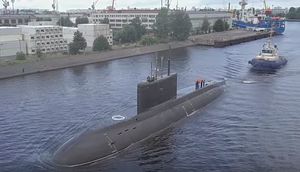The Admiralty Shipyard in St. Petersburg has delivered the first improved Project 636.3 Kilo-class (aka Vashavyanka-class) diesel-electric attack submarine (SSK), the Petropavlovsk-Kamchatsky, destined for service in the Russian Pacific Fleet, to the Russian Navy on November 25.
The submarine was handed over during a ceremony at the Admiralty Shipyard, which is part of Russia’s United Shipbuilding Corporation, on November 25. The handover event was presided over by the Russian Navy’s First Deputy Commander-in-Chief, Vice-Admiral Andrei Volozhinsky.
“This remarkable series of ships continues,” Volozhinsky was quoted as saying by TASS news agency during the ceremony. “The submarines for the Pacific Fleet have already undergone some modernization. … The most advanced solutions are incorporated in this ship. Today is a remarkable day because the Navy will get another combat ship and transfer it to the Pacific Fleet, which has long been waiting for the renewal of its submarine force.”
The Petropavlovsk-Kamchatsky was laid down in July 2017 together with the Project 636.3 SSK Volkhov. The SSK successfully completed the final round of sea and user trials in the Baltic Sea earlier this year. Two more SSKs of the class were laid down at the beginning of November. The Admiralty shipyard is expected to deliver a total of six new improved Project 636.3 SSKs to the Russian Navy’s Pacific Fleet by the end of 2025. As I wrote previously:
Between August 2010 and November 2016, Admiralty shipyard built six improved Project 636.3 SSKs for the Russian Navy’s Black Sea Fleet. Five of the subs were deployed to the eastern Mediterranean, with at least two reportedly attacking land targets inside Syria with M-54 Kalibr (NATO designation: SS-N-27A “Sizzler”) cruise missiles in 2015 and 2017.
The Volkhov is slated to join the fleet in late 2020 or 2021. It is unclear when the Volkhov or Petropavlovsk-Kamchatsky will become fully operational and deploy with the Pacific Fleet. The improved Project 636.3 Kilo-class SSKs (referred to as “Black Holes” by the U.S. Navy) is known for its quietness and features some of Russia’s most advanced submarine technology, as I explained elsewhere:
The Project 636.3 Kilo-class is an improved variant of the original Project 877 Kilo-class design. The updated version is slightly longer in length — the sub’s submerged displacement is around 4,000 tons — and features improved engines, an improved combat system, as well as new noise reduction technology.
Each SSK has a crew of 52 and can conduct underwater patrols for up to 45 days. The sub can dive to a maximum depth of about 300 meters and has an operational range of up to 12,000 kilometers. It is armed with both torpedoes and cruise missiles.
































